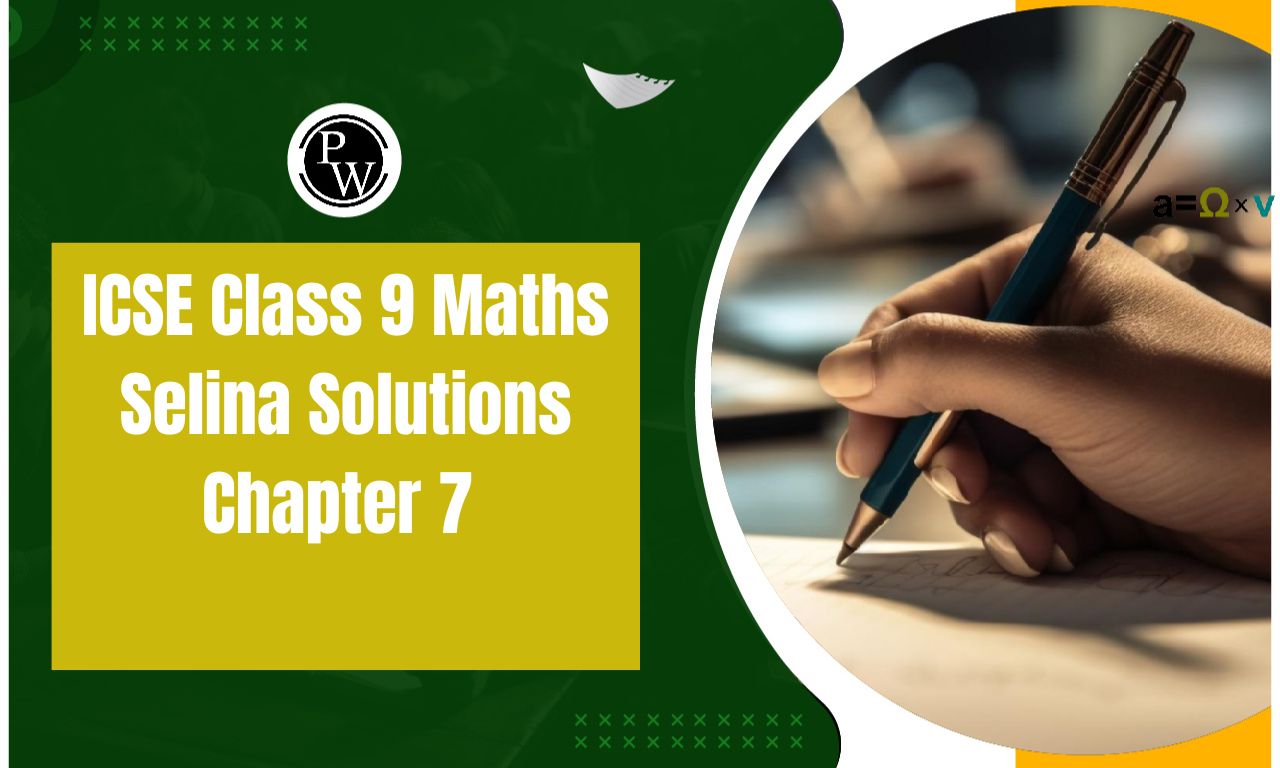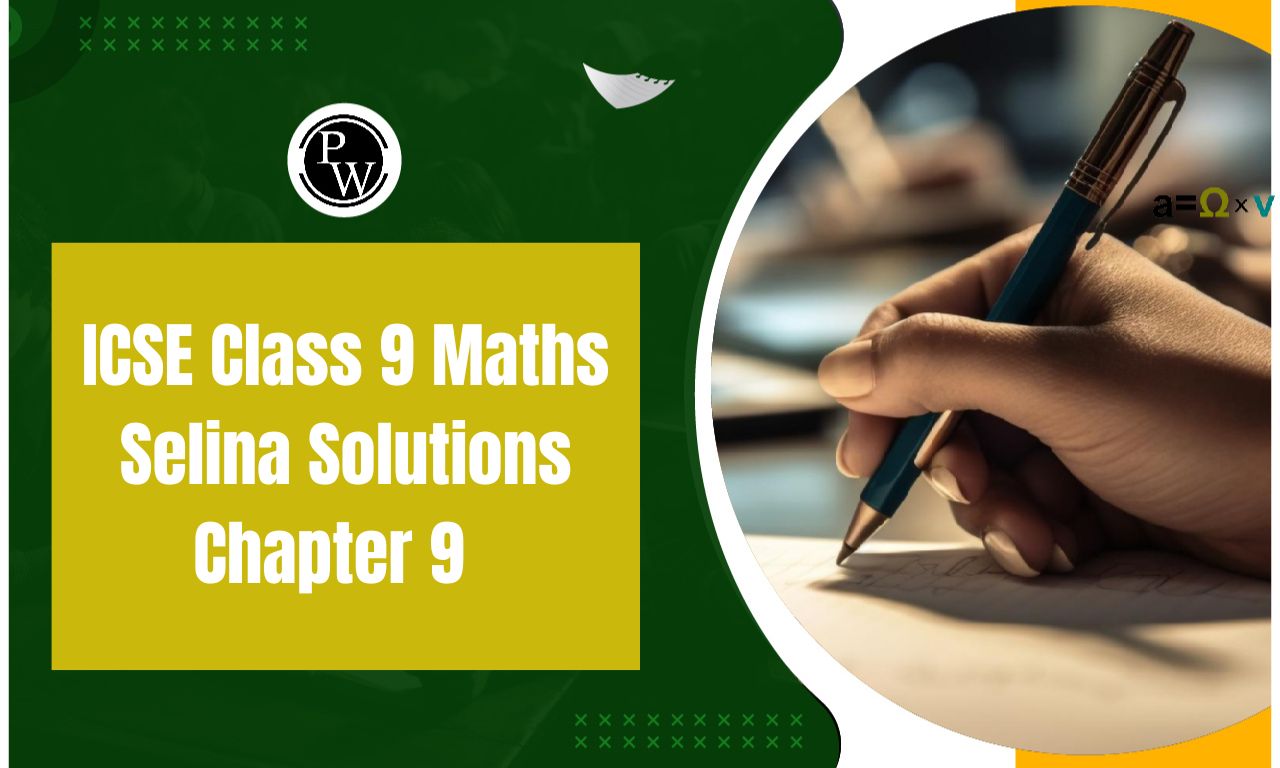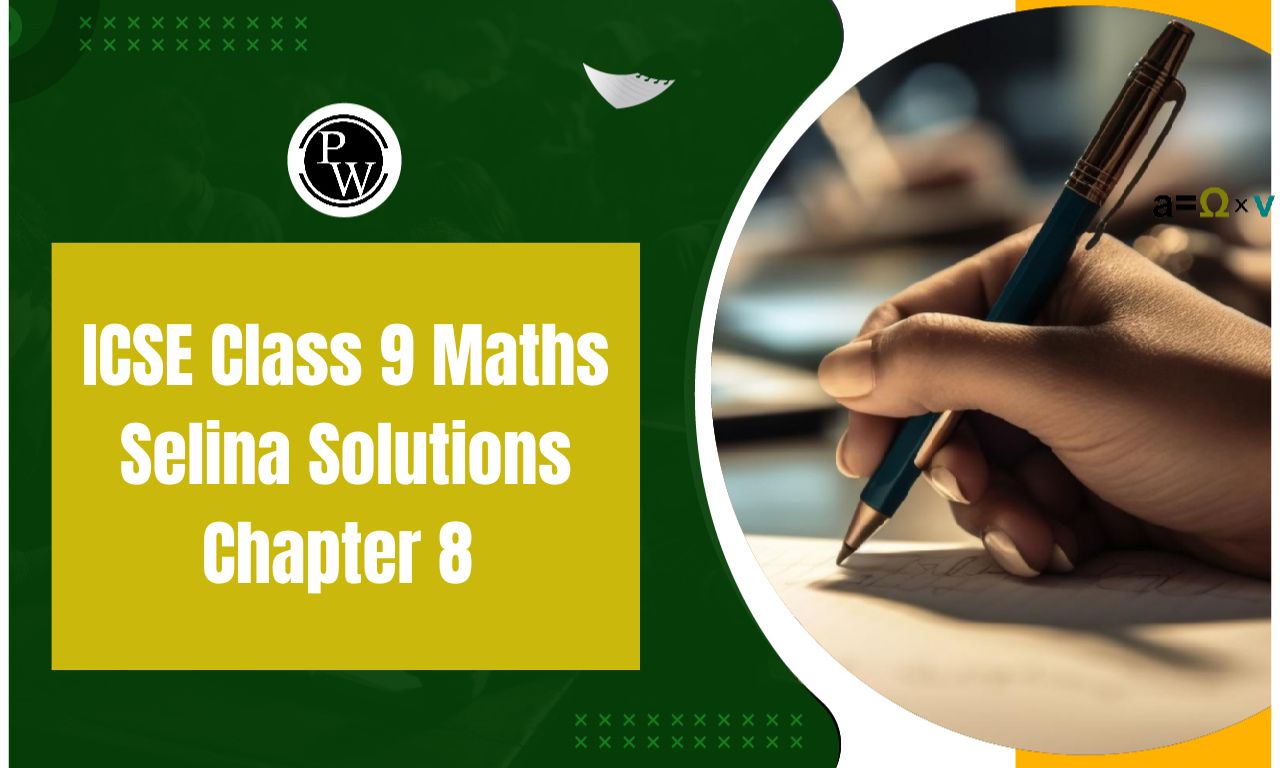
ICSE Class 9 Maths Selina Solution Chapter 7: The ICSE Class 9 Maths Selina Solution Chapter 7 is useful for students because it helps them to get high marks in the exam. Selina Solutions contains a detailed step-by-step explanation of all the problems in Chapter 7 Indices [Exponents] of Selina's Class 9 Notebook. To score well in the ICSE Class 9 Maths exam, it is recommended to solve the questions and for your betterment, we have provided the ICSE Class 9 Maths Selina Solutions Chapter 7 Indices (Exponents).
ICSE Class 9 Maths Selina Solutions Chapter 7
In mathematics, the index is called the power or exponent to which the number is raised. For example, in the expression 3², 2 is the index of 3. The plural of index is indexes. Simply put, the index determines how many times any number is multiplied by itself. Example: In the expression 2³ 2 is the base and 3 is the index. We read this term "2 to the power of 3" and it can be solved as : 2 × 2 × 2 = 8. The ICSE Class 9 Maths Selina Solutions Chapter 7 Indices (Exponents) would create a stronger foundation for the students for the next school year. One of the most critical requirements to achieve this is to have a reliable and resourceful tool that provides a clear overview of the topics covered in the Selina Notebook and makes learning effortless.ICSE Class 9 Maths Selina Solutions Chapter 7 PDF
We provide you with detailed answers and solutions for Selina's solutions for ICSE Class 9 Maths Chapter 7- Indices (Exponents). Subject experts have prepared these questions as per the syllabus prescribed by CISCE for ICSE. In our article we have provided ICSE Class 9 Mathematics Selina Solution Chapter 7 PDF. Here ICSE Class 9 Mathematics Selina Solutions Chapter 7 PDF file can be downloaded and viewed online as we have included direct download link below for easy and convenient access for candidates. Students can use and download these Selina solutions for offline practice for free.ICSE Class 9 Maths Selina Solutions Chapter 7 PDF
ICSE Class 9 Maths Selina Solutions Chapter 7 Indices (Exponents)
Here we have provided ICSE Class 9 Maths Selina Solutions Chapter 7 – Indices (Exponent) for the ease of students so that they can prepare better for their ICSE Class 9 Maths Exam.ICSE Class 9 Maths Selina Solutions Chapter 7 Exercise 7(A)
1. Evaluate:
(i) 3 3 x (243) -2/3 x 9 -1/3
(ii) 5 -4 x (125) 5/3 ÷ (25) -1/2
(iii) (27/125) 2/3 x (9/25) -3/2
(iv) 7 0 x (25) -3/2 – 5 -3
(v) (16/81) -3/4 x (49/9) 3/2 ÷ (343/216) 2/3
Solution:
(i) 3 3 x (243) -2/3 x 9 -1/3 = 3 3 x (3 x 3 x 3 x 3 x 3) -2/3 x (3 x 3) -1/3 = 3 3 x (3 5 ) -2/3 x (3 2 ) -1/3 = 3 3 x (3) -10/3 x 3 -2/3 [As (a m ) n = a mn ] = 3 3 – 10/3 – 2/3 [a m x a n x a p = a m + n + p ] = 3 (9 – 10 – 2)/3 = 3 -3/3 = 3 -1 = 1/3(ii) 5 -4 x (125) 5/3 ÷ (25) -1/2 = 5 -4 x (5 x 5 x 5) 5/3 ÷ (5 x 5) -1/2 = 5 -4 x (5 3 ) 5/3 ÷ (5 2 ) -1/2 = 5 -4 x (5 3 x 5/3 ) ÷ (5 2 x -1/2 ) [As (a m ) n = a mn ] = 5 -4 x 5 5 ÷ 5 -1 = 5 -4 x 5 5 x 5 -(-1) [As 1/a -m = a -(-m) = a m ] = 5 (-4 + 5 + 1) [a m x a n x a p = a m + n + p ] = 5 2 = 25 (iii) (27/125) 2/3 x (9/25) -3/2 = (3 x 3 x 3/5 x 5 x 5) 2/3 x (3 x 3/5 x 5) -3/2 = (3 3 /5 3 ) 2/3 x (3 2 /5 2 ) -3/2 = (3/5) 3 x 2/3 x (3/5) 2 x -3/2 [As (a m ) n = a mn ] = (3/5) 2 x (3/5) -3 = (3/5) 2 – 3 [a m x a n = a m + n ] = (3/5) -1 = 5/3 (iv) 7 0 x (25) -3/2 – 5 -3 = 1 x (5 x 5) -3/2 – 5 -3 [As a 0 = 1] = (5 2 ) -3/2 – 5 -3 = (5) 2 x -3/2 – 5 -3 [As (a m ) n = a mn ] = 5 -3 – 5 -3 = 1/5 3 – 1/5 3 = 0 (v) (16/81) -3/4 x (49/9) 3/2 ÷ (343/216) 2/3 = (2 x 2 x 2 x 2/3 x 3 x 3 x 3) -3/4 x (7 x 7/3 x 3) 3/2 ÷ (7 x 7 x 7/6 x 6 x 6) 2/3 = (2 4 /3 4 ) -3/4 x (7 2 /3 2 ) 3/2 ÷ (7 3 /6 3 ) 2/3 = (2/3) 4 x -3/4 x (7/3) 2 x 3/2 ÷ (7/6) 3 x 2/3 = (2/3) -3 x (7/3) 3 ÷ (7/6) 2 [As (a m ) n = a mn ] = [1/(2/3) 3 x (7/3) 3 ]/ (7/6) 2 [As a -m = 1/a m ] = [(3/2) 3 x (7/3) 3 ] x (7/6) -2 = (3/2) 3 x (7/3) 3 x (6/7) 2 [As (a/b) -m = (b/a) m ] = 3/2 x 3/2 x 3/2 x 7/3 x 7/3 x 7/3 x 6/7 x 6/7 = (7 x 3 x 3)/2 = 63/2 = 31.5
2. Simplify:
(i) (8x 3 ÷ 125y 3 ) 2/3
(ii) (a + b) -1 . (a -1 + b -1 )
(iii)

(iv) (3x 2 ) -3 × (x 9 ) 2/3
Solution:
(i) (8x 3 ÷ 125y 3 ) 2/3 = (8x 3 /125y 3 ) 2/3 = (2x × 2x × 2x/5y × 5y × 5y) 2/3 = (2x 3 /5y 3 ) 2/3 = (2x/5y) 3 x 2/3 = (2x/5y) 2 = 4x 2 /25y 2 (ii) (a + b) -1 . (a -1 + b -1 ) = 1/(a + b) x (1/a + 1/b) = 1/(a + b) x (b + a)/ab = 1/ab(iii)

(iv) (3x 2 ) -3 × (x 9 ) 2/3 = 3 -3 × (x 2 ) -3 × (x) 9 x 2/3 = 3 -3 × (x) 2 x -3 × (x) 9 x 2/3 = 3 -3 × x -6 × x 6 = 3 -3 x 1 = 1/27
3. Evaluate:
(i) √¼ + (0.01) -1/2 – (27) 2/3
(ii) (27/8) 2/3 – (1/4) -2 + 5 0
Solution:
(i) √¼ + (0.01) -1/2 – (27) 2/3 = √(½ x ½) + (0.1 x 0.1) -1/2 – (3 x 3 x 3) 2/3 = √(½) 2 + (0.1 2 ) -1/2 – (3 3 ) 2/3 = ½ + (0.1) 2 x -1/2 – (3) 3 x 2/3 = ½ + (0.1) -1 – (3) 2 = ½ + 1/0.1 – 3 2 = ½ + 1/(1/10) – 9 = ½ + 10 – 9 = ½ + 1 = 3/2(ii) (27/8) 2/3 – (1/4) -2 + 5 0 = (3 x 3 x 3/2 x 2 x 2) 2/3 – (1/2 x 1/2) -2 + 5 0 = (3 3 /2 3 ) 2/3 – (½) 2 ) -2 + 1 = (3/2) 3 x 2/3 – (½) -4 + 1 = (3/2) 2 – (½) -4 + 1 = (3/2) 2 – 2 4 + 1 = (3 x 3)/(2 x 2) – (2 x 2 x 2 x 2) + 1 = 9/4 – 16 + 1 = (9 – 64 + 4)/4 = -51/4
4. Simplify each of the following and express with positive index:
(i) (3 -4 /2 -8 ) 1/4
(ii) (27 -3 /9 -3 ) 1/5
(iii) (32) -2/5 ÷ (125) -2/3
(iv) [1 – {1 – (1 – n) -1 } -1 ] -1
Solution:
(i) (3 -4 /2 -8 ) 1/4 = (2 8 /3 4 ) 1/4 = (2 8 ) 1/4 /(3 4 ) 1/4 = (2) 8/4 /(3) 4/4 = 2 2 /3 = 4/3 (ii) (27 -3 /9 -3 ) 1/5 = (9 3 /27 3 ) 1/5 = [(3 x 3) 3 /(3 x 3 x 3) 3 ] 1/5 = [(3 2 ) 3 /(3 3 ) 3 ] 1/5 = [(3) 2 x 3 /(3) 3 x 3 ] 1/5 = [(3) 6 /(3) 9 ] 1/5 = [(3) 6-9 ] 1/5 = (3) -3 x 1/5 = (3) -3/5 = 1/3 3/5(iii) (32) -2/5 ÷ (125) -2/3 = (32) -2/5 /(125) -2/3 = (125) 2/3 /(32) 2/5 = (5 x 5 x 5) 2/3 /(2 x 2 x 2 x 2 x 2) 2/5 = (5 3 ) 2/3 /(2 5 ) 2/5 = 5 3 x 2/3 /2 5 x 2/5 = 5 2 /2 2 = 25/4 (iv) [1 – {1 – (1 – n) -1 } -1 ] -1 = [1 – {1 – 1/(1 – n)} -1 ] -1 = [1 – {((1 – n) – 1)/(1 – n)} -1 ] -1 = [1 – {– n/(1 – n)} -1 ] -1 = [1 – {– (1 – n)/n}] -1 = [1 + (1 – n)/n] -1 = [(n + 1 – n)/n] -1 = [1/n] -1 = n
5. If 2160 = 2 a . 3 b . 5 c , find a, b and c. Hence, calculate the value of 3 a x 2 -b x 5 -c .
Solution:
We have, 2160 = 2 a x 3 b x 5 c (2 x 2 x 2 x 2) x (3 x 3 x 3) x 5 = 2 a x 3 b x 5 c 2 4 x 3 3 x 5 1 = 2 a x 3 b x 5 c ⇒ 2 a x 3 b x 5 c = 2 4 x 3 3 x 5 1 Comparing the exponents of 2, 3 and 5 on both sides, we get a = 4, b = 3 and c = 1 Hence, the value 3 a x 2 -b x 5 -c = 3 4 x 2 -3 x 5 -1 = (3 x 3 x 3 x 3) x (½ x ½ x ½) x 1/5 = 81 x 1/8 x 1/5 = 81/406. If 1960 = 2 a . 5 b . 7 c , calculate the value of 2 -a . 7 b . 5 -c .
Solution:
We have, 1960 = 2 a x 5 b x 7 c (2 x 2 x 2) x 5 x (7 x 7) = 2 a x 5 b x 7 c 2 3 x 5 1 x 7 2 = 2 a x 5 b x 7 c ⇒ 2 a x 5 b x 7 c = 2 2 x 5 1 x 7 2 Comparing the exponents of 2, 5 and 7 on both sides, we get a = 3, b = 1 and c = 2 Hence, the value 2 -a . 7 b . 5 -c = 2 -3 x 7 1 x 5 -2 = (½ x ½ x ½) x 7 x (1/5 x 1/5) = 1/8 x 7 x 1/25 = 7/200
7. Simplify:
(i)

(ii)

Solution:
(i)

(ii)

8. Show that:
(a m /a -n ) m-n × (a n /a -l ) n-l × (a l /a -m ) l-m = 1
Solution:
Taking the L.H.S., we have (a m /a -n ) m-n × (a n /a -l ) n-l × (a l /a -m ) l-m = (a m × a n ) m-n × (a n ×a l ) n-l × (a l × a m ) l-m = (a m+n ) m-n × (a n+l ) n-l × (a l+m ) l-m

9. If a = x m+n . x l ; b = x n+l . x m and c = x l+m . x n ,
Prove that: a m-n . b n-l . c l-m = 1
Solution:
We have, a = x m+n . x l b = x n+l . x m c = x l+m . x n Now, Considering the L.H.S., a m-n . b n-l . c l-m = (x m+n . x l ) m-n . (x n+l . x m ) n-l . (x l+m . x n ) l-m = [x (m+n)(m-n) . x l(m-n) ]. [x (n+l)(n-l) . x m(n-l) ]. [x (l+m)(l-m) . x n(l-m) ]

10. Simplify:
(i)

(ii)

Solution:
(i)

(ii)

Exercise 7(B)
1. Solve for x:
(i) 2 2x+1 = 8
(ii) 2 5x-1 = 4 × 2 3x + 1
(iii) 3 4x + 1 = (27) x + 1
(iv) (49) x + 4 = 7 2 × (343) x + 1
Solution:
(i) We have, 2 2x+1 = 8 ⇒2 2x+1 = 2 3 Now, if the bases are equal, then the powers must be equal On comparing the exponents, we get 2x + 1 = 3 2x = 3 – 1 2x = 2 x = 2/2 x = 1 (ii) We have, 2 5x-1 = 4 × 2 3x + 1 ⇒ 2 5x-1 = 2 2 × 2 3x + 1 2 5x-1 = 2 (3x + 1) + 2 2 5x-1 = 2 3x + 3 Now, if the bases are equal, then the powers must be equal On comparing the exponents, we get 5x – 1 = 3x + 3 5x – 3x = 3 + 1 2x = 4 x = 4/2 x = 2 (iii) We have, 3 4x + 1 = (27) x + 1 3 4x + 1 = (3 3 ) x + 1 3 4x + 1 = (3) 3x + 3 Now, if the bases are equal, then the powers must be equal On comparing the exponents, we get 4x + 1 = 3x + 3 4x – 3x = 3 – 1 x = 2 (iv) We have, (49) x + 4 = 7 2 × (343) x + 1 (7 x 7) x + 4 = 7 2 × (7 x 7 x 7) x + 1 (7 2 ) x + 4 = 7 2 × (7 3 ) x + 1 (7) 2x + 8 = (7) 3x + 3 + 2 (7) 2x + 8 = (7) 3x + 5 Now, if the bases are equal, then the powers must be equal On comparing the exponents, we get 2x + 8 = 3x + 5 3x – 2x = 8 – 5 x = 32. Find x, if:
(i) 4 2x = 1/32
(ii) √(2 x+3 ) = 16
(iii) [√(⅗)] x+1 = 125/27
(iv) [∛(⅔)] x-1 = 27/8
Solution:
(i) We have, 4 2x = 1/32 (2 × 2) 2x = 1/(2 × 2 × 2 × 2 × 2) (2 2 ) 2x = 1/2 5 2 4x = 2 -5 Now, if the bases are equal, then the powers must be equal So, on comparing the exponents, we get 4x = -5 x = -5/4 (ii) We have, √(2 x+3 ) = 16 (2 x+3 ) 1/2 = (2 × 2 × 2 × 2) 2 (x+3)/2 = 2 4 Now, if the bases are equal, then the powers must be equal So, on comparing the exponents, we get (x + 3)/2 = 4 x + 3 = 8 x = 8 – 3 x = 5 (iii) We have, [√(⅗)] x+1 = 125/27 [(⅗) 1/2 ] x+1 = (5 × 5 × 5)/(3 × 3 × 3) (⅗) (x+1)/2 = 5 3 /3 3 (⅗) (x+1)/2 = (5/3) 3 (⅗) (x+1)/2 = (3/5) -3 Now, if the bases are equal, then the powers must be equal So, on comparing the exponents, we get (x + 1)/2 = -3 x + 1 = -6 x = -6 – 1 x = -7 (iv) We have, [∛(⅔)] x-1 = 27/8 [(⅔) 1/3 ] x-1 = (3 × 3 × 3)/(2 × 2 × 2) (⅔) (x-1)/3 = (3/2) 3 (⅔) (x-1)/3 = (2/3) -3 Now, if the bases are equal, then the powers must be equal So, on comparing the exponents, we get (x – 1)/3 = -3 x – 1 = -9 x = -9 + 1 x = -83. Solve:
(i) 4 x-2 – 2 x+1 = 0
(ii)

Solution:
(i) We have, 4 x-2 – 2 x+1 = 0 (2 2 ) x-2 – 2 x+1 = 0 2 2x-4 – 2 x+1 = 0 2 2x-4 = 2 x+1 Now, if the bases are equal, then the powers must be equal So, on comparing the exponents, we get 2x – 4 = x + 1 2x – x = 4 + 1 x = 5 (ii) We have, Now, if the bases are equal, then the powers must be equal
So, on comparing the exponents, we get
x
2
= x+ 2
x
2
– x – 2 = 0
On factorization, we get
x
2
– 2x + x – 2 = 0
x(x – 2 + 1(x – 2) = 0
(x + 1)(x – 2) = 0
So, either (x + 1) = 0 or (x – 2) = 0
Thus, x = -1 or 2
Now, if the bases are equal, then the powers must be equal
So, on comparing the exponents, we get
x
2
= x+ 2
x
2
– x – 2 = 0
On factorization, we get
x
2
– 2x + x – 2 = 0
x(x – 2 + 1(x – 2) = 0
(x + 1)(x – 2) = 0
So, either (x + 1) = 0 or (x – 2) = 0
Thus, x = -1 or 2
4. Solve:
(i) 8 × 2 2x + 4 × 2 x+1 = 1 + 2 x
(ii) 2 2x + 2 x+2 – 4 × 2 3 = 0
(iii) (√3) x-3 = (∜3) x+1
Solution:
(i) We have, 8 × 2 2x + 4 × 2 x+1 = 1 + 2 x 8 × (2 x ) 2 + 4 × (2 x ) × 2 1 = 1 + 2 x Let us substitute 2 x = t Then, 8 × t 2 + 4 × t × 2 = 1 + t 8t 2 + 8t = 1 + t 8t 2 + 8t – t – 1 = 0 8t 2 + 7t – 1 = 0 8t 2 + 8t – t – 1 = 0 8t(t + 1) – 1(t + 1) = 0 (8t – 1)(t + 1) = 0 So, either 8t – 1 = 0 or t + 1 = 0 Thus, t = 1/8 or -1 Now, we have 2 x = t So, 2 x = 1/8 or 2 x = -1 The equation, 2 x = -1 is not possible Hence, for 2 x = 1/8 2 x = 1/(2 × 2 × 2) 2 x = 1/2 3 2 x = 2 -3 Now, if the bases are equal, then the powers must be equal So, on comparing the exponents, we get x = -3(ii) We have, 2 2x + 2 x+2 – 4 × 2 3 = 0 2 2x + 2 x+2 – 2 2 × 2 3 = 0 (2 x ) 2 + 2 x .2 2 – 2 3+2 = 0 (2 x ) 2 + 2 x .2 2 – 2 5 = 0 Now, let’s assume 2 x = t So, the above equation becomes (t) 2 + t.2 2 – 2 5 = 0 t 2 + 4t – 32 = 0 On factorization, we have t 2 + 8t – 4t – 32 = 0 t(t + 8) – 4(t + 8) = 0 (t – 4)(t + 8) = 0 So, either (t – 4) = 0 or (t + 8) = 0 Thus, t = 4 or -8 Now, we have t = 2 x So, 2 x = 4 or 2 x = -8 The equation, 2 x = -8 is not possible Hence, for 2 x = 4 2 x = 2 2 On comparing the exponents, we get x = 2
(iii) (√3) x-3 = (∜3) x+1 (3 1/2 ) x-3 = (3 1/4 ) x+1 3 (x-3)/2 = 3 (x+1)/4 Now, if the bases are equal, then the powers must be equal So, on comparing the exponents, we get (x – 3)/2 = (x + 1)/4 2(x – 3) = (x + 1) 2x – 6 = x + 1 2x – x = 6 + 1 x = 7
5. Find the values of m and n if:
4 2m = (∛16) -6/n = (√8) 2
Solution:
We have, 4 2m = (∛16) -6/n = (√8) 2 Now, considering 4 2m = (√8) 2 (2 2 ) 2m = (8 1/2 ) 2 2 4m = 8 1/2 x 2 2 4m = 8 ⇒ 2 4m = 2 3 Now, if the bases are equal, then the powers must be equal So, on comparing the exponents, we get 4m = 3 m = ¾ Now, from the given considering (∛16) -6/n = (√8) 2 (16 1/3 ) -6/n = (8 1/2 ) 2 (16) 1/3 x -6/n = 8 1/2 x 2 (16) -2/n = 8 (2 x 2 x 2 x 2) -2/n = (2 x 2 x 2) (2) 4 x -2/n = 2 3 (2) -8/n = 2 3 Now, if the bases are equal, then the powers must be equal So, on comparing the exponents, we get -8/n = 3 n = -8/3 Therefore, the value of m and n are ¾ and -8/3
6. Solve x and y if:
(√32) x ÷ 2 y+1 = 1 and 8 y – 16 4 – x/2 = 0
Solution:
Consider the equation, (√32) x ÷ 2 y+1 = 1 (√(2 × 2 × 2 × 2 × 2)) x ÷ 2 y+1 = 1 (√2 5 ) x ÷ 2 y+1 = 1 (2 5 ) 1/2 × x ÷ 2 y+1 = 1 2 5x/2 ÷ 2 y+1 = 1 (2 5x/2 )/(2 y+1 ) = 1 2 5x/2 – (y+1) = 2 0 Now, if the bases are equal, then the powers must be equal So, on comparing the exponents, we get 5x/2 – (y+1) = 0 5x/2 – y – 1 = 0 5x – 2y – 2 = 0 … (i) Next, let’s consider 8 y – 16 4 – x/2 = 0 (2 × 2 × 2) y – (2 × 2 × 2 × 2) 4 – x/2 = 0 (2 3 ) y – (2 4 ) 4 – x/2 = 0 2 3y – 2 16 – 2x = 0 2 3y = 2 16 – 2x Now, if the bases are equal, then the powers must be equal So, on comparing the exponents, we get 3y = 16 – 2x 2x + 3y – 16 = 0 … (ii) On solving equations (i) and (ii), By manipulating by (i) × 3 + (ii) × 2, we have 15x – 6y – 6 = 0 4x + 6y – 32 = 0 ———————– 19x – 38 = 0 x = 38/19 x = 2 Now, substituting the value of x in (i) 5(2) – 2y – 2 = 0 10 – 2y – 2 = 0 8 = 2y y = 8/2 y = 4 Therefore, the values of x and y are 2 and 4 respectively7. Prove that:
(i) (x a /x b ) a+b-c . (x b /x c ) b+c-a . (x c /x a ) c+a-b = 1
(ii) x a(b-c) /x b(a-c) ÷ (x b /x a ) c = 1
Solution:
(i) Taking L.H.S, we have (x a /x b ) a+b-c . (x b /x c ) b+c-a . (x c /x a ) c+a-b = (x a /x b ) a+b-c . (x b /x c ) b+c-a . (x c /x a ) c+a-b = x (a-b)(a+b-c) . x (b-c)(b+c-a) . x (c-a)(c+a-b) = x
0
= 1
= R.H.S
= x
0
= 1
= R.H.S
(ii) Taking L.H.S, we have x a(b-c) /x b(a-c) ÷ (x b /x a ) c = x a(b-c) – b(a-c) ÷ x c(b-a) = x a(b-c) – b(a-c) /x c(b-a) = x a(b-c) – b(a-c) – c(b-a) = x ab-ac-ba+bc-cb+ac = x 0 = 1 = R.H.S
8. If a x = b, b y = c and c z = a, prove that: xyz = 1.
Solution:
We have, a x = b, b y = c and c z = a Now, considering a x = b On raising to the power yz on both sides, we get (a x ) yz = (b) yz (a) xyz = (b y ) z (a) xyz = (c) z [As, b y = c] a xyz = a a xyz = a 1 [As, c z = a] Now, if the bases are equal, then the powers must be equal On comparing the exponents, we get Hence, xyz = 19. If a x = b y = c z and b 2 = ac, prove that: y = 2az/(x + z).
Solution:
Let’s assume a x = b y = c z = k So, a = k 1/x ; b = k 1/y and c = k 1/z Now, It’s given that b 2 = ac ⇒ (k 1/y ) 2 = (k 1/x ) × (k 1/z ) (k 2/y ) = k 1/x + 1/z k 2/y = k (z+x)/xz Now, if the bases are equal, then the powers must be equal On comparing the exponents, we get 2/y = (z + x)/xz 2xz = y(z + x) Hence, y = 2xz/(x + z)10. If 5 -p = 4 -q = 20 r , show that: 1/p + 1/q + 1/r = 0.
Solution:
Let’s assume 5 -p = 4 -q = 20 r = k Then, as 5 -p = k ⇒ 5 = k -1/p 4 -q = k ⇒ 4 = k -1/q 20 r = k ⇒ 20 = k 1/r Now, we know 5 x 4 = 20 (k -1/p ) x (k -1/q ) = k 1/r k -1/p – 1/q = k 1/r Now, if the bases are equal, then the powers must be equal On comparing the exponents, we get -1/p – 1/q = 1/r Hence, 1/p + 1/q + 1/r = 0
11. If m ≠ n and (m + n) -1 (m -1 + n -1 ) = m x n y , show that: x + y + 2 = 0
Solution:
Given equation, (m + n) -1 (m -1 + n -1 ) = m x n y 1/(m + n) × (1/m + 1/n) = m x n y 1/(m + n) × (m + n)/mn = m x n y 1/mn = m x n y m -1 n -1 = m x n y Now, if the bases are equal, then the powers must be equal On comparing the exponents, we get x = -1 and y = -1 Substituting the values of x and y in the equation x + y + 2 = 0, we have (-1) + (-1) + 2 = 0 0 = 0 L.H.S = R.H.S Therefore, x + y + 2 = 0
12. If 5 x + 1 = 25 x – 2 , find the value of 3 x – 3 × 2 3 – x
Solution:
We have, 5 x + 1 = 25 x – 2 5 x + 1 = (5 2 ) x – 2 5 x + 1 = 5 2x – 4 Now, if the bases are equal, then the powers must be equal On comparing the exponents, we get x + 1 = 2x – 4 2x – x = 4 + 1 x = 5 Hence, the value of 3 x – 3 × 2 3 – x = 3 5 – 3 × 2 3 – 5 = 3 2 × 2 -2 = 9 × ¼ = 9/413. If 4 x + 3 = 112 + 8 × 4 x , find the value of (18x) 3x .
Solution:
We have, 4 x + 3 = 112 + 8 × 4 x 4 x .4 3 = 112 + 8 × 4 x Let’s assume 4 x = t Then, t .4 3 = 112 + 8 × t 64t = 112 + 8t 64t – 8t = 112 56t = 112 t = 112/56 t = 2 But we have taken 4 x = t So, 4 x = 2 (2 2 ) x = 2 1 2 2x = 2 1 Now, if the bases are equal, then the powers must be equal On comparing the exponents, we get 2x = 1 x = ½ Now, the value of (18x) 3x will be = (18 × ½) 3 × 1/2 = (9) 3/2 = (3 2 ) 3/2 = 3 3 = 2714. Solve for x:
(i) 4 x-1 × (0.5) 3 – 2x = (1/8) -x
Solution:
We have, 4 x-1 × (0.5) 3 – 2x = (1/8) -x (2 2 ) x-1 × (1/2) 3 – 2x = (1/2 3 ) -x (2) 2x-1 × (2) -(3 – 2x) = (2 -3 ) -x (2) 2x-2 × (2) 2x-3 = (2) 3x 2 (2x-2) + (2x-3) = (2) 3x 2 4x-5 = 2 3x Now, if the bases are equal, then the powers must be equal On comparing the exponents, we get 4x – 5 = 3x 4x – 3x = 5 x = 5
(ii) (a 3x + 5 ) 2 × (a x ) 4 = a 8x + 12
Solution:
We have, (a 3x + 5 ) 2 × (a x ) 4 = a 8x + 12 a 6x + 10 × a 4x = a 8x + 12 a 6x + 10 + 4x = a 8x + 12 a 10x + 10 = a 8x + 12 Now, if the bases are equal, then the powers must be equal On comparing the exponents, we get 10x + 10 = 8x + 12 10x – 8x = 12 – 10 2x = 2 x = 1(iii) (81) 3/4 – (1/32) -2/5 + x(1/2) -1 × 2 0 = 27
Solution:
We have, (81) 3/4 – (1/32) -2/5 + x(1/2) -1 × 2 0 = 27 (3 4 ) 3/4 – (1/2 5 ) -2/5 + x(1/2) -1 × 2 0 = 27 (3 4 ) 3/4 – (2 -5 ) -2/5 + x(2 -1 ) -1 × 2 0 = 27 3 3 – 2 2 + 2x × 1 = 27 27 – 4 + 2x = 27 2x + 23 = 27 2x = 27 – 23 2x = 4 x = 4/2 x = 2
(iv) 2 3x + 3 = 2 3x + 1 + 48
Solution:
We have, 2 3x + 3 = 2 3x + 1 + 48 2 3x + 3 – 2 3x + 1 = 48 2 3x (2 3 – 2 1 ) = 48 2 3x (8 – 2) = 48 2 3x × 6 = 48 2 3x = 48/6 2 3x = 8 2 3x = 2 3 Now, if the bases are equal, then the powers must be equal On comparing the exponents, we get 3x = 3 x = 1(v) 3(2 x + 1) – 2 x+2 + 5 = 0
Solution:
We have, 3(2 x + 1) – 2 x+2 + 5 = 0 3 × 2 x + 3 – 2 x .2 2 + 5 = 0 2 x (3 – 2 2 ) + 5 + 3 = 0 2 x (3 – 4) + 8 = 0 -2 x + 8 = 0 2 x = 8 2 x = 2 3 Now, if the bases are equal, then the powers must be equal On comparing the exponents, we get x = 3
(vi) 9 x+2 = 720 + 9 x
Solution:
We have, 9 x+2 = 720 + 9 x 9 x+2 – 9 x = 720 9 x (9 2 – 1) = 720 9 x (81 – 1) = 720 9 x (80) = 720 9 x = 9 9 x = 9 1 Therefore, x = 1Exercise 7(C)
1. Evaluate:
(i) 9 5/2 – 3 x 8 0 – (1/81) -1/2
(ii) (64) 2/3 – ∛125 – 1/2 -5 + (27) -2/3 x (25/9) -1/2
(iii) [(-2/3) -2 ] 3 x (1/3) -4 x 3 -1 x 1/6
Solution:
(i) We have, 9 5/2 – 3 x 8 0 – (1/81) -1/2 = (3 2 ) 5/2 – 3 x 1 – (1/9 2 ) -1/2 = 3 2 x 5/2 – 3 – (1/9) -2 x ½ = 3 5 – 3 – (1/9) -1 = (3 x 3 x 3 x 3 x 3) – 3 – (9 -1 ) -1 = 243 – 3 – 9 = 231 (ii) We have, (64) 2/3 – ∛125 – 1/2 -5 + (27) -2/3 x (25/9) -1/2 = (4 x 4 x 4) 2/3 – (5 x 5 x 5) 1/3 – 1/2 -5 + (3 x 3 x 3) -2/3 x (5 x 5/3 x 3) -1/2 = (4 3 ) 2/3 – (5 3 ) 1/3 – (2 -1 ) -5 + (3 3 ) -2/3 x (5 2 /3 2 ) -1/2 = (4) 3 x 2/3 – (5) 3 x 1/3 – (2) -1 x -5 + (3) 3 x -2/3 x (5/3) 2 x -1/2 = (4) 2 – 5 – 2 5 + 3 -2 x (5/3) -1 = 16 – 5 – 32 + 1/9 x 3/5 = -21 + 1/15 = (-315 + 1)/15 = -314/15 (iii) We have, [(-2/3) -2 ] 3 x (1/3) -4 x 3 -1 x 1/6 = (-2/3) -6 x (3 -1 ) -4 x 3 -1 x ½ x 1/3 = (-3/2) 6 x 3 4 x 3 -1 x 2 -1 x 3 -1 = (-1) 6 x (3 6 x 3 4 x 3 -1 x 3 -1 ) x (2 -6 x 2 -1 ) = 1 x 3 6+4-1-1 x 2 -6-1 = 3 8 x 2 -7 = 3 8 /2 7
2. Simplify:
![]()
Solution:
We have,

3. Solve: 3 x-1 × 5 2y-3 = 225.
Solution:
Given, 3 x-1 × 5 2y-3 = 225 3 x-1 × 5 2y-3 = 9 x 25 3 x-1 × 5 2y-3 = 3 2 x 5 2 Now, if the bases are equal, then the powers must be equal On comparing the exponents, we get x – 1 = 2 and 2y – 3 = 2 x = 2 + 1 and 2y = 2 + 3 x = 3 and 2y = 5 x = 3 and y = 5/2 = 2.54. If [(a -1 b 2 )/(a 2 b -4 )] 7 ÷ [(a 3 b -5 )/(a -2 b 3 )] = a x .b y , find x + y.
Solution:
We have,

5. If 3 x+1 = 9 x-3 , find the value of 2 1+x .
Solution:
We have, 3 x+1 = 9 x-3 3 x × 3 1 = (3 2 ) x – 3 3 x × 3 1 = (3) 2x – 6 3 x = (3) 2x – 6 /3 3 x = (3) 2x – 6 × 3 -1 3 x = (3) 2x – 6 – 1 3 x = 3 2x – 7 Now, if the bases are equal, then the powers must be equal On comparing the exponents, we get x = 2x – 7 x = 7 Now, 2 1+x = 2 1+7 = 2 8 = 2566. If 2 x = 4 y = 8 z and 1/2x + 1/4y + 1/8z = 4, find the value of x.
Solution:
Given, 2 x = 4 y = 8 z 2 x = (2 2 ) y = (2 3 ) z 2 x = 2 2y = 2 3z On comparing the powers, we get x = 2y = 3z y = x/2 and z = x/3 Now, 1/2x + 1/4y + 1/8z = 4 1/2x + 1/4(x/2) + 1/8(x/3) = 4 1/2x + 2/4x + 3/8x = 4 1/2x + 1/2x + 3/8x = 4 (4 + 4 + 3)/8x = 4 11/8x = 4 4 × 8x = 11 32x = 11 x = 11/32
7. If

Show that: m – n = 1
Solution:
We have,

8. Solve for x: (13) √x = 4 4 – 3 4 – 6.
Solution:
We have, (13) √x = 4 4 – 3 4 – 6 = 256 – 81 – 6 = 169 = 13 2 13 √x = 13 2 On comparing the powers, we get √x = 2 Squaring on both sides, x = 2 2 x = 49. If 3 4x = (81) -1 and (10) 1/y = 0.0001, find the value of 2 -x × 16 y .
Solution:
We have, 3 4x = (81) -1 and (10) 1/y = 0.0001 3 4x = (3 4 ) -1 and (10) 1/y = 1/10000 3 4x = 3 -4 and 10 1/y = 1/10 -4 3 4x = 3 -4 and 10 1/y = 1/10 4 3 4x = 3 -4 and 10 1/y = 10 -4 On comparing the powers, we get 4x = -4 and 1/y = -4 x = -1 and y = -1/4 Now, value of 2 -x × 16 y = 2 -(-1) × 16 -1/4 = 2 1 × (2 4 ) -1/4 = 2 x 2 -1 = 2/2 = 1
10. Solve: 3(2 x + 1) – 2 x+2 + 5 = 0.
Solution:
We have, 3(2 x + 1) – 2 x+2 + 5 = 0 (3 × 2 x + 3) – (2 x × 2 2 ) + 5 = 0 2 x (3 – 2 2 ) + 3 + 5 = 0 2 x (3 – 4) + 8 = 0 2 x (-1) + 8 = 0 -2 x + 8 = 0 2 x = 8 2 x = 2 3 On comparing the powers, we get x = 311. If (a m ) n = a m .a n , find the value of: m(n – 1) – (n – 1)
Solution:
We have, (a m ) n = a m .a n a mn = a m+n On comparing the powers, we get mn = m + n … (i) Now, m(n – 1) – (n – 1) = mn – m – n + 1 = (m + n) – m – n + 1 … [Form (i)] = 112. If m = ∛15 and n = ∛14, find the value of m – n – 1/(m 2 + mn + n 2 )
Solution:
We have, m = ∛15 and n = ∛14 ⇒ m = 15 3 and n = 14 3

13. Evaluate:

Solution:
We have,

14. Evaluate:
(x q /x r ) 1/qr × (x r /x p ) 1/rp × (x p /x q ) 1/pq
Solution:
We have,

15. (i) Prove that: a -1 /(a -1 + b -1 ) + a -1 /(a -1 – b -1 ) = 2b 2 /(b 2 – a 2 )
Solution:
We have,

(ii) Prove that: (a + b + c)/(a -1 b -1 + b -1 c -1 + c -1 a -1 ) = abc
Solution:
Taking L.H.S., we have

16. Evaluate: 4/(216) -2/3 + 1/(256) -3/4 + 2/(243) -1/5
Solution:
We have,

Benefits of ICSE Class 9 Maths Selina Solutions Chapter 7 – Indices (Exponents)
1. Helps to plan a preparation strategy
Attempting ICSE Class 9 Maths Selina Solutions Chapter 7 Indices (Exponent) is the best strategy to prepare for the exam. Candidates can plan study table for all subjects and give more time to weak sections. By this candidates can attempt all the questions during the exam. And at the closing time, they have to perfect everything they have learned.2. Preparation Level Overview
One of the best advantages of ICSE Class 9 Maths Selina Solutions Chapter 7 Indices (Exponent) it helps candidates know where they stand in terms of their preparation level. This helps candidates know where they are lagging behind. Candidates can learn from their mistakes and follow the test exam solutions and strategies.3. Performance analysis
No one can learn anything unless they analyze their performance. Candidates can know their weak and strong points only by analyzing them. Analyzing the ICSE Class 9 Maths solution Chapter 7 will make the candidates aware that they will not repeat their mistakes in the exam hall. Analyzing the solutions helps the candidate to get an idea of where they stand in the competition to take the ICSE Class 9 Maths Exam.5. Time planning aids
A candidate cannot afford to deal with a question that takes time. Some questions can be difficult and some can be solved at a glance. ICSE Class 9 Maths Selina Solutions Chapter 7 help candidates to develop such skills. Candidates will implement the question solving pattern with right approach which will help them to crack the exam on time. Solving most of the questions in less time, they give the remaining time to the more difficult parts.6. Improve Accuracy and Speed
It helps candidates to improve accuracy and speed. The more they solve different questions, the better they explain their concepts and tricks. Accuracy and speed are important in the selection process. This will help them clear the upcoming ICSE class 9 Maths Exam.ICSE Class 9 Maths Selina Solutions Chapter 7 FAQs
Q1. What is Indices (Exponent)?
Q2. Where can I get the ICSE Class 9 Maths Selina Solutions Chapter 7 Indices (Exponent)?
Q3. Is ICSE Class 9 Maths Selina Solutions Chapter 7 PDF available to download?
Q4. What are the Benefits of ICSE Class 9 Maths Selina Solutions Chapter 7 Indices (Exponent)?
Q5. Are ICSE Class 9 Maths Selina Solutions Chapter 7 useful for exam preparation?










